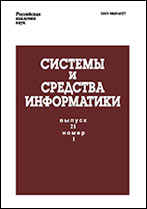|
Stationary characteristics of the two-node Markovian tandem queueing system with general renovation
L. A. Meykhanadzhyana, I. S. Zaryadovbc, T. A. Milovanovab
a Department of Data Analysis and Machine Learning, Financial University under the Government of the Russian Federation, 49 Leningradsky Prosp., Moscow 125993, Russian Federation
b Peoples' Friendship University of Russia (RUDN University), 6 Miklukho- Maklaya Str., Moscow 117198, Russian Federation
c Institute of Informatics Problems, Federal Research Center "Computer Science and Control" of the Russian Academy of Sciences, 44-2 Vavilov Str., Moscow 119133, Russian Federation
Abstract:
Consideration is given to the Markovian tandem queueing system with two finite-capacity heterogeneous nodes, say node 1 and node 2. The output of node 1 is the input into node 2. Each node is a single-server queue with a Poisson incoming flow of customers and service times having Erlang distribution. The service discipline is FIFO (first in, first out). General renovation is implemented in each node which implies that upon a service completion, a customer may remove a random number of customers from the queue (if any is available), with a given probability distribution; removed customers leave the system. Using the matrix-geometric technique, one derives the joint stationary distribution of the nodes' states. A recursive algorithm for computation of the stationary loss probabilities under the head-of-the-queue renovation is also proposed.
Keywords:
queueing system, tandem, general renovation, queue management.
Received: 11.08.2020
Citation:
L. A. Meykhanadzhyan, I. S. Zaryadov, T. A. Milovanova, “Stationary characteristics of the two-node Markovian tandem queueing system with general renovation”, Sistemy i Sredstva Inform., 30:3 (2020), 14–31
Linking options:
https://www.mathnet.ru/eng/ssi715 https://www.mathnet.ru/eng/ssi/v30/i3/p14
|

|




 Contact us:
Contact us: Terms of Use
Terms of Use
 Registration to the website
Registration to the website Logotypes
Logotypes








 Citation in format
Citation in format 